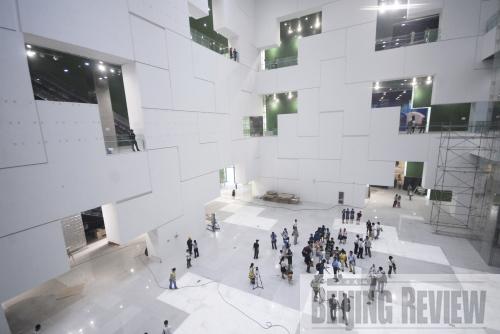|
"The aim is to inspire audiences' interest," Xu said. "We are trying to provide rich content to satisfy audiences of different ages."
To achieve that goal, museum designers built four special cinemas and five display themes—Children's Science Paradise, Glory of China, Exploration and Discovery, Science, Technology and Life and Challenges and the Future.
The museum's construction costs 790 million yuan ($116 million).
"We have a professional research team and a 1,500-square-meter research laboratory to guarantee the timely update of the exhibits," Xu said.
The new museum also adopted radio-frequency identification (RFID) technology for its tickets, making them information gatherers that record the activities of audiences.
"We will adjust the content of our exhibitions and operations by analyzing audience activities," he said. "Interaction is the spirit of the new museum."
There are about 800 interactive items throughout the museum, which is the most among the world's science and technology institutions, said Huang Timao, vice curator of the museum.
"Through interaction, children can learn more about modern science and technologies," Xu said.
The museum also includes a public research area with a robot and a life science laboratory to cultivate the manipulative abilities of the public. Experts at the museum will give direction and training to visitors.
"The development of information technology in recent years gives us a good opportunity to take our exhibitions to a higher level," said Xu.
Museum treasures
 |
|
WORLD OF SCIENCES: Visitors appreciate the new China Science and Technology Museum in advance on August 18 (WEI YAO) | On August 18, the museum held a ceremony to welcome three dinosaur fossils from the dinosaur theme park World Dinosaur Valley in Chuxiong Yi Autonomous Prefecture of southwest Yunnan Province.
Though the fossils were placed on the floor unassembled, it remained quite a scene to see lying together the 27-meter-long Chuanjiesaurus, the middle Jurassic period's largest, the 7.1-meter-long Lufengosaurus huenei, known as China's first dinosaur, and the 7-meter-long Chinese Dilophosaurus, a rare carnivorous dinosaur.
Each animal has more than 300 bones, making assembly a complicated task requiring the work of experts. Ten specialists have been assembling the fossils since August 19, using careful planning that takes into account the size and weight of the fossils, said Wang Tao, an expert from the World Dinosaur Valley. The dinosaurs will eventually be assembled into different poses.
The new museum will put the three dinosaurs into an exhibition that reproduces the ecological conditions of the ages in which they lived, Xu said. They will be placed in the central hall of the museum, which is 40 meters long and 26 meters high. There are main exhibition rooms around the central hall on the second, third and fourth floors. Audiences can view the dinosaur skeletons from many different angles, Xu said. | 